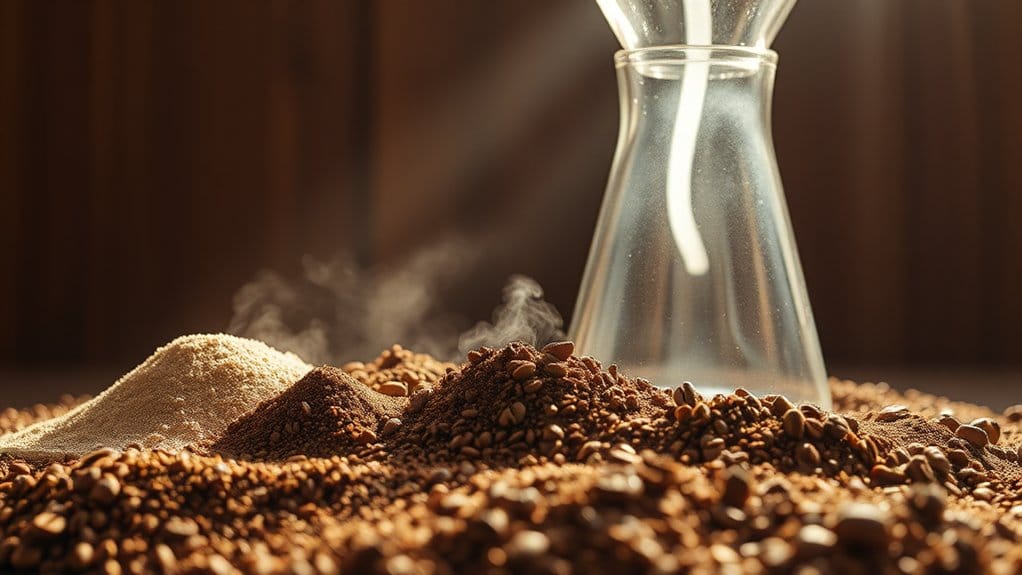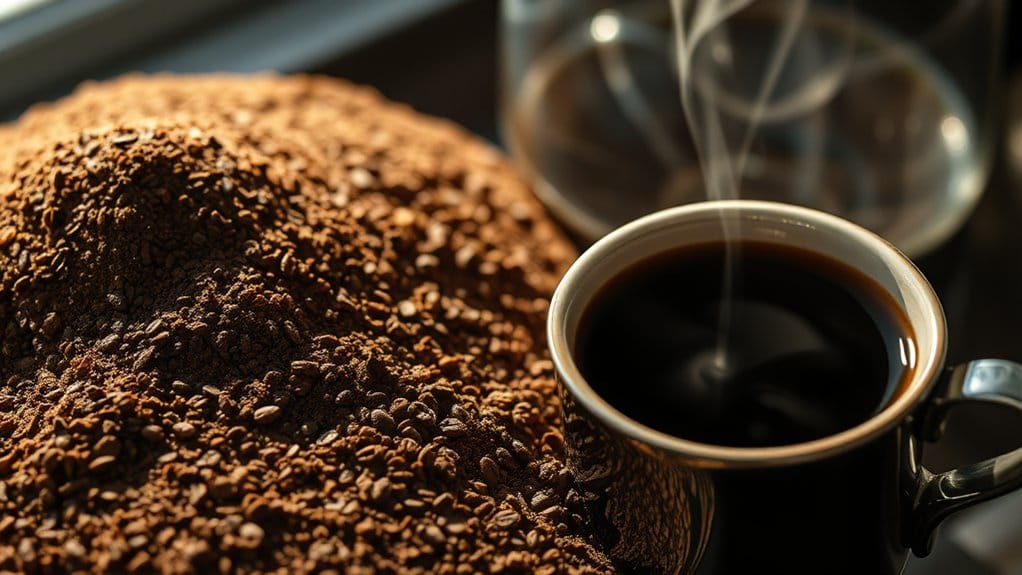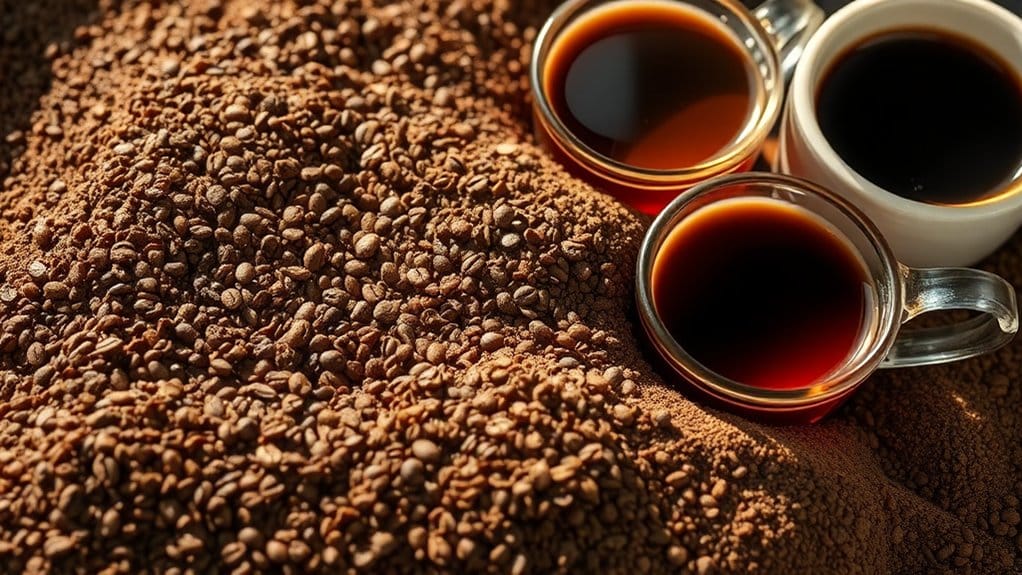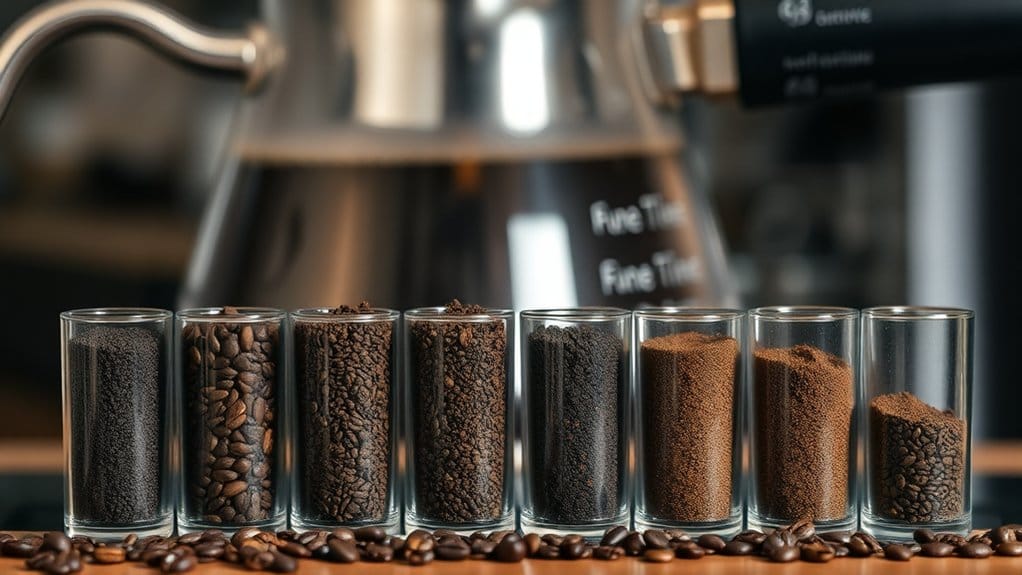Physical Address
304 North Cardinal St.
Dorchester Center, MA 02124
Physical Address
304 North Cardinal St.
Dorchester Center, MA 02124

Grind size is like the secret seasoning in your coffee pot! If you grind too fine, you might end up with a bitter brew, whereas a coarse grind can leave you with a sour sip. Finer grinds extract quicker, perfect for espresso, whereas coarse grinds are great for French press. Think of it as fine-tuning your flavor experience! Want to know how other factors can jazz up your coffee? Stick around; there’s more to investigate!

Understanding grind size is one of the secrets to brewing a great cup of coffee. When you use a finer grind, more surface area meets the water, speeding up extraction. Think of it as diving into a pool—bigger splashes mean quicker results!
Coarser grinds, on the other hand, take longer to extract flavors, so you’ll need to brew a bit more. If you’re not careful, too-fine grinds can make your coffee bitter, whereas coarse grinds might leave you with a sour sip. Finding that Goldilocks zone is key! Attention to grind size is essential for optimal brewing, as different methods require precise adjustments. Additionally, achieving ideal TDS levels—the total dissolved solids measured in your brew—can significantly influence the flavor and quality of your coffee. Freshly ground beans typically provide the best flavor profile, helping you to fully unlock the potential of your chosen grind size.
You’ll want to match your grind to your brewing method—espresso loves fine, whereas French press prefers coarse. Experimenting with grind size isn’t just science; it’s an adventure for your taste buds!
Even though you might think of coffee simply as a drink, the science of particle size distribution (PSD) reveals a world of complexity beneath your favorite brew.
Imagine measuring the tiny bits of your coffee grounds, noticing how some are big, whereas others are tiny. This measurement helps you understand how each particle size contributes to extraction. Fine particles, less than 200 micrometers, extract quickly, whereas coarse particles, up to 2 millimeters, take their time. Proper grind size is essential for enhancing optimal flavor extraction, ensuring you achieve the perfect balance in your brew. As you experiment with various grind sizes, the impact on extraction becomes evident, helping you refine your brewing technique.
When you’ve got a mix of sizes, your extraction can get a bit wild—think of a party with both shy and outgoing guests. Understanding PSD means you can brew better coffee, ensuring that every cup packs the perfect punch of flavor and strength. Additionally, burr design shows a significant impact on the uniformity of grind sizes, influencing extraction rates directly.
Enjoy the expedition!

When you brew coffee, the grind size can make a world of difference in your flavor experience. Using finer grinds, you’ll unveil bolder and more intense flavors, like a punchy espresso that wakes your taste buds up. On the flip side, coarser grinds yield a smoother, milder cup—think cozy coffee during lazy weekends. It gets tricky; if you grind too fine, your coffee can turn bitter, and nobody wants that! Striking the right balance is key for great acidity and body. Plus, finer grinds boost your coffee’s aroma, filling your space with delightful scents. Optimal extraction can only be achieved by experimenting with grind sizes to find your perfect cup. Understanding the grind size-extraction relationship can significantly enhance your brewing process. So, experiment with grind size to find your perfect cup. It’s like a flavor playground, waiting for you to uncover!
Selecting the right grind size for your brewing method can totally improve your coffee game, so let’s investigate!
For immersion methods, like French press, coarsely-ground coffee resembles chunky salt, ensuring a balanced brew without bitter sediment. Cold brew? Go extra coarse, like peppercorns, to keep it smooth after hours of brewing.
Now, if you’re pulling an espresso shot, aim for that very fine grind, similar to table salt, to maximize extraction under high pressure. It’s a delicate balance, and even a slight change can turn your shot from heavenly to a bitter flop.
Pour-over lovers should stick to a medium grind, which flows evenly through the filter, ensuring a flavorful cup every time. To achieve the best flavor profile, it’s essential to understand the grind size importance in the brewing process.

Grind size is just one piece of the coffee puzzle, but there’s so much more that can affect how your brew turns out.
Water temperature plays a huge role; aim for 90°C to 95°C. Too hot and you’ll end up with bitter flavors, too cool, and you’ll miss out on rich aromas.
The coffee-to-water ratio is essential too. Typically, a ratio of 1:15 works well, but tweak it to suit your taste.
Brew time matters just as much; longer contact means more flavor extraction. Don’t forget your roast level, as light and dark roasts behave differently!
Finally, the brewing equipment impacts everything. Each type offers a unique experience, so experiment and find your perfect match! For example, using an espresso machine can significantly alter the flavor extraction due to the pressure applied during brewing.
Enjoy the expedition!
Grind size impacts coffee acidity levels directly. Finer grinds extract more acidic compounds quickly, creating a brighter taste, whereas coarser grinds yield less acidity. Adjusting the grind allows you to achieve your desired flavor profile.
Yes, grind size definitely influences coffee aroma during brewing. A finer grind boosts aroma release because of increased surface area, whereas a coarser grind limits it, resulting in weaker aromatic profiles. Consistency is key for the best results.
To achieve uniform grind size, you should invest in a burr grinder. Models like the Baratza Sette 270 or Breville Smart Grinder Pro provide consistency and precision, essential for enhancing your coffee brewing experience.
You should change your grind size settings whenever you switch coffee beans, brewing methods, or notice flavor inconsistencies. Regular adjustments keep your extraction consistent, enhancing the overall quality of your brewed coffee.
Yes, grind size definitely impacts caffeine extraction. Finer grinds increase surface area, leading to higher caffeine extraction in shorter brew times, whereas coarser grinds take longer but yield less caffeine overall. Choose wisely for best results.